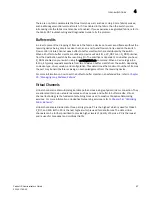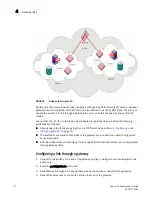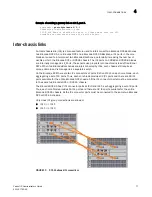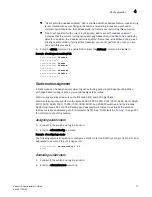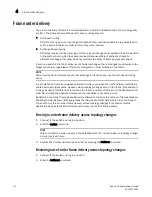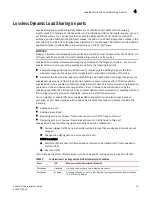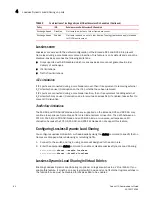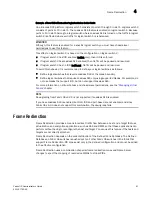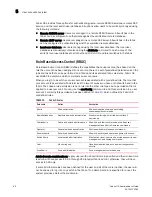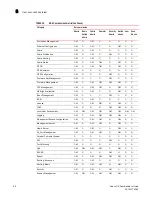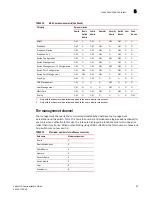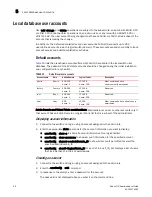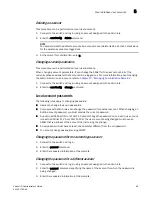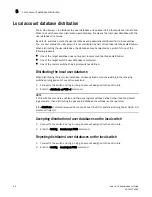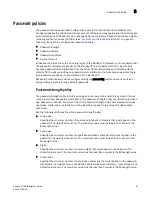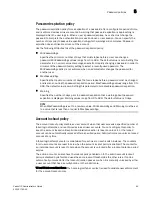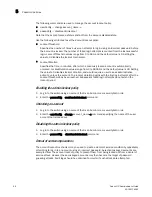
Fabric OS Administrator’s Guide
81
53-1001763-02
Frame Redirection
4
Example of how DLS affects other logical switches in the fabric
On a Brocade DCX platform, logical switch 1 consists of ports 0 through 5 in slot 1. Logical switch 2
consists of ports 6–10 in slot 1. The Lossless DLS feature is enabled on logical switch 1. Because
ports 0–10 in slot 1 belong to a logical switch where Lossless DLS is turned on, the traffic in logical
switch 2 is affected whenever traffic for logical switch 1 is rebalanced.
ATTENTION
Although, this feature is enabled for a specific logical switch, you must have chassis-level
permissions to use this feature.
This effect on logical switch 2 is based on the configuration on logical switch 2:
•
If logical switch 2 has IOD enabled (iodSet only), then IOD is enforced.
•
If logical switch 2 has Lossless DLS enabled, then traffic will be paused and resumed.
•
If logical switch 2 has no IOD (iodReset), traffic will be paused and resumed.
To avoid this behavior, it is recommended to define your logical switches as follows:
•
Define logical switches that require Lossless DLS at the blade boundary.
•
Define logical switches that require Lossless DLS only using supported blades. For example, do
not use blades that support IOD, but do not support Lossless DLS.
For more information on Virtual Fabrics and chassis-level permissions, see the
“Managing Virtual
Fabrics”
chapter.
NOTE
Downgrading from Fabric OS v6.2.0 is not supported if Lossless DLS is enabled.
If you have Lossless DLS is enabled, but DLS, IOD and port-based are not enabled, and since
Fabric OS v6.3.0 does not support this combination, the downgrade fails.
Frame Redirection
Frame Redirection provides a means to redirect traffic flow between a host and a target that use
virtualization and encryption applications, such as SAS and DMM, so that those applications can
perform without having to reconfigure the host and target. You can use this feature if the hosts and
targets are not directly attached.
Frame Redirection depends on the wide distribution of the Defined Zone Database. The Defined
Database on Fabric OS switches is pushed out to all other Fabric OS switches in the fabric that
support Frame Redirection. RD zones exist only in the defined configuration and cannot be added
to the effective configuration.
Frame Redirection uses a combination of special frame redirection zones and Name Server
changes to spoof the mapping of real device WWNs to Virtual PIDs.
Summary of Contents for 53-1001763-02
Page 1: ...53 1001763 02 13 September 2010 Fabric OS Administrator s Guide Supporting Fabric OS v6 4 0 ...
Page 4: ...iv Fabric OS Administrator s Guide 53 1001763 02 ...
Page 24: ...xxiv Fabric OS Administrator s Guide 53 1001763 02 ...
Page 28: ...xxviii Fabric OS Administrator s Guide 53 1001763 02 ...
Page 32: ...xxxii Fabric OS Administrator s Guide 53 1001763 02 ...
Page 40: ...xl Fabric OS Administrator s Guide 53 1001763 02 ...
Page 42: ...2 Fabric OS Administrator s Guide 53 1001763 02 ...
Page 54: ...14 Fabric OS Administrator s Guide 53 1001763 02 High availability of daemon processes 1 ...
Page 74: ...34 Fabric OS Administrator s Guide 53 1001763 02 Basic connections 2 ...
Page 102: ...62 Fabric OS Administrator s Guide 53 1001763 02 Audit log configuration 3 ...
Page 214: ...174 Fabric OS Administrator s Guide 53 1001763 02 Management interface security 7 ...
Page 228: ...188 Fabric OS Administrator s Guide 53 1001763 02 Brocade configuration form 8 ...
Page 276: ...236 Fabric OS Administrator s Guide 53 1001763 02 Creating a logical fabric using XISLs 10 ...
Page 404: ...364 Fabric OS Administrator s Guide 53 1001763 02 ...
Page 440: ...400 Fabric OS Administrator s Guide 53 1001763 02 Performance data collection 17 ...
Page 480: ...440 Fabric OS Administrator s Guide 53 1001763 02 F_Port masterless trunking 19 ...
Page 494: ...454 Fabric OS Administrator s Guide 53 1001763 02 Buffer credit recovery 20 ...
Page 574: ...534 Fabric OS Administrator s Guide 53 1001763 02 Hexadecimal overview E ...

